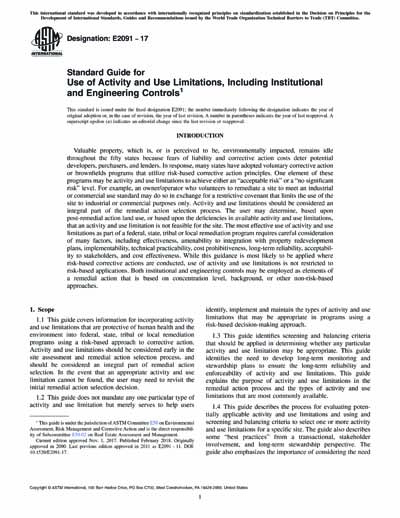Historical
ASTM E2091-17
Standard Guide for Use of Activity and Use Limitations, Including Institutional and Engineering Controls
1.1 This guide covers information for incorporating activity and use limitations that are protective of human health and the environment into federal, state, tribal or local remediation programs using a risk-based approach to corrective action. Activity and use limitations should be considered early in the site assessment and remedial action selection process, and should be considered an integral part of remedial action selection. In the event that an appropriate activity and use limitation cannot be found, the user may need to revisit the initial remedial action selection decision.
1.2 This guide does not mandate any one particular type of activity and use limitation but merely serves to help users identify, implement and maintain the types of activity and use limitations that may be appropriate in programs using a risk-based decision-making approach.
1.3 This guide identifies screening and balancing criteria that should be applied in determining whether any particular activity and use limitation may be appropriate. This guide identifies the need to develop long-term monitoring and stewardship plans to ensure the long-term reliability and enforceability of activity and use limitations. This guide explains the purpose of activity and use limitations in the remedial action process and the types of activity and use limitations that are most commonly available.
1.4 This guide describes the process for evaluating potentially applicable activity and use limitations and using and screening and balancing criteria to select one or more activity and use limitations for a specific site. The guide also describes some “best practices” from a transactional, stakeholder involvement, and long-term stewardship perspective. The guide also emphasizes the importance of considering the need for, and potential applicability of, activity and use limitations EARLY in the remedial action process. This guide can be used to effectively implement risk based corrective action.
1.5 All references to specific Federal or state programs are current as of the date of publication. The user is cautioned not to rely on this guide alone but to consult directly with the appropriate program.
1.6 The values stated in SI units are to be regarded as standard. No other units of measurement are included in this standard.
1.7 This standard does not purport to address all of the safety concerns, if any, associated with its use. It is the responsibility of the user of this standard to establish appropriate safety, health, and environmental practices and determine the applicability of regulatory limitations prior to use.
1.8 This international standard was developed in accordance with internationally recognized principles on standardization established in the Decision on Principles for the Development of International Standards, Guides and Recommendations issued by the World Trade Organization Technical Barriers to Trade (TBT) Committee.
Content Provider
ASTM International [astm]






